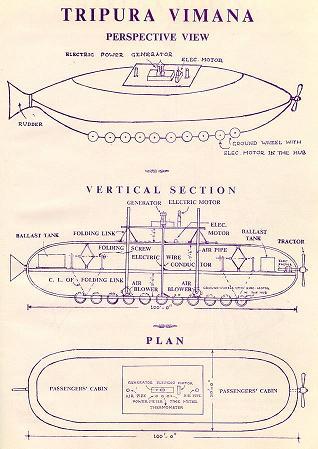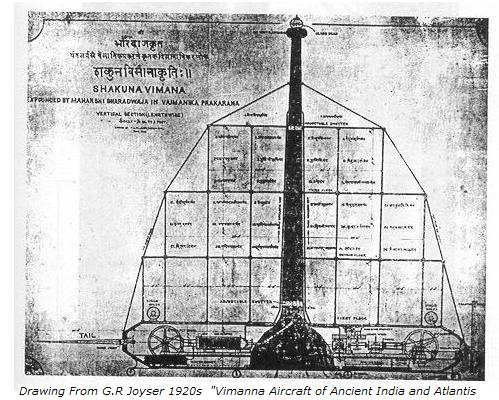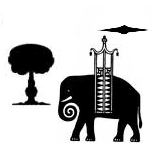|
Vimana Aircraft of Ancient India & Atlantis


|
Dr. Shivakar Bapuji Talpade
<Back
A 19th Century Indian Sanskrit scholar, Dr. Shivakar Bapuji Talpade did experimentation on aircraft based on ancient Hindu texts in particular Rig-Bashya Bhumika , Vyaamnaika Shastra and Samaranga Sutradhara . He designed a Mercury Ion engine that was flown unmanned in 1895 to 1500 feet on a beach near Bombay, before it crashed.
Evan Koshtka [Writer- Times Union], described Talpade as the ‘first creator of an aircraft’ [In the Modern era anyway]. The event was witnessed by the Maharaja of Baroda, the state justice and published by Kesari news paper. Dr. Tapede continued his experiments but the project ended with his Death in 1917.
Dr. Tapede proved that vimanas were not simply objects of mythology. In the 1930s and 40s German Nazi scientists began experimenting in the same field , and there is strong indications that they may have been successful. Dr. Talpede named his invention Marutsakhā ["Marut-Air or Stream of Air, Sakha Friend"]
A flight over Chowpatty that made history Times of India October 2004
The following is an excerpt from the New York Herald Tribune of February 16, 1947
"When the first atomic bomb exploded in New Mexico, the desert sand turned to fused green glass. This fact, according to the magazine Free World, has given certain archaeologists a turn. They have been digging in the ancient Euphrates Valley and have uncovered a layer of agrarian culture 8,000 years old, and a layer of herdsman culture much older, and a still older caveman culture. Recently, they reached another layer of fused green glass. "
The Archeological chronology as described above tends to indicate that most recently the civilization of the region was an agricultural society, preceded by a shepherds society, preceded by a caveman society which arose from the ashes of whatever [whoever] caused that layer of "fused green glass" . The knowledge of flight is just below that fused green glass, and the cavemen are some of the descendants of the few regional survivors of this tremendous cataclysmic event. The cataclysmic event that brought down the previous Golden age of man. The UFOs being witnessed around the World for the several thousand years , Are piloted, I Speculate, by other descendants of survivors of the cataclysmic event who have maintained a society [secret] that in some way or form has preserved memories and fragmentary technologies from the Golden Age, and /or by a secretive group of people who have capitalized on , built upon and taken full advantage of this forgotten technology of the ancients.
|
|
Ancient documentation of aircraft
<Back
The Vimanas of the Rama Empire
Numerous ancient texts speak of highly advanced aircraft and techniques so sophisticated that 21st man has yet to achieve such a level. The Vimanas of ancient India are clearly the most intriguing. Many texts and epic poems are frequently cited . Written texts that have come down to us through the eons. Most of them have never been translated into English.
Rig-Veda  --(c. 1200–900 bc) is a collection of more than 1,000 individual Sanskrit hymns. At least 20 passages in the Rig-Veda refer exclusively to the flying vehicle of the Asvins. --(c. 1200–900 bc) is a collection of more than 1,000 individual Sanskrit hymns. At least 20 passages in the Rig-Veda refer exclusively to the flying vehicle of the Asvins.
"Now Vata's chariot's greatness! Breaking goes it, And Thunderous is its noise, To heaven it touches, Makesa red fiery glare, and whirls dust upon the earth." - Rig-Veda / (Vata: Aryan god of wind.)
"The [A]Hakatha , a supplemental commentary to Laws Of Ancient Babylon states .... "The privilege of operating a flying machine is great. The knowledge of flight is among the most ancient of our inheritances. A gift from 'those from upon high'. We received it from them as a means of saving many lives." [The Ark of Millions of Years: Volume Three Pg 225] Pg 225]
The Hakatha clearly states that the flying machines were of the most ancient. Keeping in mind that the Hakatha hails from the dawn of what we know as civilization, who then were ancient to the ancient Babylonians??? Certainly they are not referring to the cavemen !
The Mahabharata , an extremely ancient epic, of unknown chronological origin, gives an account by Krishna that is highly suggestive of modern weaponry , an extremely ancient epic, of unknown chronological origin, gives an account by Krishna that is highly suggestive of modern weaponry
"His Saubha clung to the sky at a league's length...He threw at me rockets, missiles, spears, spikes, battle-axes, three-bladed javelins, flame-throwers, without pausing....The sky...seemed to hold a hundred suns, a hundred moons...and a hundred myriad stars. Neither day nor night could be made out, or the points of compass."
"I quickly laid on an arrow, which killed by seeking out sound, to kill them...All the Danavas who had been screeching lay dead, killed by the blazing sunlike arrows that were triggered by sound."
The Ramayana , another great Indian epic which dates from at least 2,000 years ago tells the story of a Prince Rama and describes a chariot which 'arrived shining, a wonderful divine car that sped through the air'. and also mentions a chariot 'sailing overhead like a moon , another great Indian epic which dates from at least 2,000 years ago tells the story of a Prince Rama and describes a chariot which 'arrived shining, a wonderful divine car that sped through the air'. and also mentions a chariot 'sailing overhead like a moon
The Puspaka car that resembles the Sun and belongs to my brother was brought by the powerful Ravan; that aerial and excellent car going everywhere at will.... that car resembling a bright cloud in the sky.".. and the King [Rama] got in, and the excellent car at the command of the Raghira, rose up into the higher atmosphere."
Yantra Sarvasva [Encyclopedia of Machines], allegedly written by Maharshi Bhardwaj [Ca. 800 BC].
This consists of as many as 40 sections of which one, the Vaimanika Prakarana dealing with aeronautics, has 8 chapters, a hundred topics and 500 sutras. In it Bhardwaj describes vimana, or aerial aircrafts, as being of three classes. Those that travel from place to place; Those that travel from one country to another; Those that travel between planets. David Hatcher Childress  The designs, techniques and descriptions are found very impressive by Modern engineers. The designs, techniques and descriptions are found very impressive by Modern engineers.
|
| The Samarangana Sutradhara
<Back
An encyclopedic work by a King Bhoja of Dhara (c. 1000-1055 A.D.) is a technical manuscript, composed in Sanskrit circa 1000 AD. It deals with techniques of warfare, and in particular with certain types of war machines. Samarangana Sutradhara translates to "battlefield commander" . It contains over 200 stanzas on building Vimanas and their uses.
"Strong and durable must the body of the Vimana be made, like a great flying bird of light material. Inside one must put the mercury engine with its iron heating apparatus underneath. By means of the power latent in the mercury which sets the driving whirlwind in motion, a man sitting inside may travel a great distance in the sky. The movements of the Vimana are such that it can vertically ascend, vertically descend, move slanting forwards and backwards. With the help of the machines human beings can fly in the air and heavenly beings can come down to earth. "
|
|
Surya Siddhanta is a textbook of Hindu astronomy which tells of wise men who orbited the earth "below the moon and above the clouds" . The extant version only dates to the Middle Ages. A 10th century commentator , quotes sections which are not in the current version so it is know to be derived from an earlier work.
<Back
Mahavira of Bhavabhuti
<Back
(Bhavabhuti was a Brahman priest and playwright of the eighth century AD. His work is derived from older texts and traditions). The Mahavira of Bhavabhuti was a play, and not intended to be historically/factually accurate, it is a work of fiction derived from older Hindu/Sanskrit texts which are not believed to be of a fictitious nature. "An aerial chariot, the Pushpaka, conveys many people to the capital of Ayodhya. The sky is full of stupendous flying-machines, dark as night, but picked out by lights with a yellowish glare."
Miscellaneous Notes
<Back
There is another book entitled Vaimanika-sastra , dictated in trance during the 20th century which claims to be the transcription of an ancient work . "The medium was a Pandit Subbaraya Sastry, who began to dictate on August 1, 1918. This work is obviously of no Historical value whatsoever.
Also *The ancient Chaldean work, The Sifrala, is said to contain numerous pages of technical details on building a flying machine. It is said to contain words which translate as graphite rod, copper coils, crystal indicator, vibrating spheres, stable angles, etc. it is referenced in The Ark of Millions of Years: Volume Three as well as The Anti-Gravity Handbook as well as The Anti-Gravity Handbook  . And is parroted time and again across the the web [same exact phrase paste & copy one site to the next]. Perhaps there is a misspelling here or some facsimile, but I know of no work such as the Sifrala, and find very little references to it , it must be extremely obscure if it exists at all. . And is parroted time and again across the the web [same exact phrase paste & copy one site to the next]. Perhaps there is a misspelling here or some facsimile, but I know of no work such as the Sifrala, and find very little references to it , it must be extremely obscure if it exists at all.
Yavana - In early Indian literature, either a Greek or another foreigner… From the time of Alexander the Great (c. 334 BC) Yavana came to be applied more specifically to the Greek kingdom of Bactria, and, even more specifically, after about 175 BC, to the Indo-Greek kingdom in the Punjab. Indian sources of that time regarded the Yavanas as a barbarian people of the northwest…The Brihat Katha states that "As for flying machines, the Yavana [Greeks] know them"
"The army of the King looked on, with His Majesty in their midst. It was after the evening meal when the Disks ascended even higher in the sky to the south. Fish and other volatiles rained down from the sky: a marvel never before known since the foundation of the country. And His Majesty caused incense to be brought to make peace on the hearth of the gods. And it was [ordered] to be [recorded for] His Majesty in the annals of the House of Life [to be remembered] for ever."' - Tulli Papryus
External Links
<Back
Vimanas : Celestial Chariots
Ancient Excavators - Advanced Science embedded in Literature
Youtube Video -http://www.youtube.com/watch?v=JKbQiKrqaIw
Suggest a Link
Suggested Reading
<Back
|
